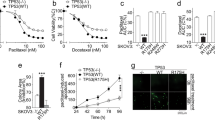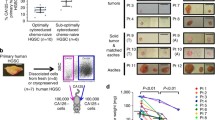Abstract
Purpose
We evaluated the effects of polyphyllin D (PD), a natural compound with anti-neoplastic activity and a major component of the Chinese herb Paris polyphylla, on ovarian cancer (OVCA) cell line proliferation and platinum sensitivity.
Methods
A panel of 20 OVCA cell lines was subjected to PD treatment, MTS proliferation assays, and determination of IC50. Pre-treatment, baseline genome-wide Affymetrix expression analysis was performed on each cell line, and Pearson’s correlation was performed to identify genes associated with OVCA PD sensitivity. Twelve cell lines were treated with PD with and without cisplatin, and the effects of PD on cisplatin IC50 were quantified. Genes associated with OVCA PD sensitivity were evaluated for associations with survival in a publically available clinico-genomic dataset of 218 patients with OVCA.
Results
Our results showed that PD exhibited anti-proliferative effects against all OVCA cell lines tested, with IC50 values ranging from 0.2 to 1.4 μm. Furthermore, in all cell lines, PD treatment significantly decreased cisplatin IC50 (mean IC50 reduction of 2.1 µm; P < 0.02). Pearson’s correlation test identified 25 probe sets, representing 18 unique genes to be associated with PD sensitivity (FDR = 0). We found that one of these genes was associated with overall survival in women with OVCA: CLDN4 (P = 0.014).
Conclusion
Our findings highlight the value of PD as a natural product with anti-cancer properties, which may also enhance the activity of existing therapeutic agents.




Similar content being viewed by others
References
Agarwal R, D’Souza T, Morin PJ (2005) Claudin-3 and claudin-4 expression in ovarian epithelial cells enhances invasion and is associated with increased matrix metalloproteinase-2 activity. Cancer Res 65:7378–7385. doi:10.1158/0008-5472.CAN-05-1036
Baker VV (2003) Salvage therapy for recurrent epithelial ovarian cancer. Hematol Oncol Clin North Am 17:977–988
Cheung JY, Ong RC-Y, Suen Y-K et al (2005) Polyphyllin D is a potent apoptosis inducer in drug-resistant HepG2 cells. Cancer Lett 217:203–211. doi:10.1016/j.canlet.2004.06.042
Gao M, Cheung KL, Lau IP et al (2012) Polyphyllin D induces apoptosis in human erythrocytes through Ca(2)(+) rise and membrane permeabilization. Arch Toxicol 86:741–752. doi:10.1007/s00204-012-0808-4
Hansen HH, Eisenhauer EA, Hansen M et al (1993) New cytostatic drugs in ovarian cancer. Ann Oncol 4(Suppl 4):63–70
Kong M, Fan J, Dong A, Cheng H, Xu R (2010) Effects of polyphyllin I on growth inhibition of human non-small lung cancer cells and in xenograft. Acta Biochim Biophys Sin (Shanghai) 42:827–833. doi:10.1093/abbs/gmq091
Lee MS, Chan JY-W, Kong S-K et al (2005) Effects of polyphyllin D, a steroidal saponin in Paris polyphylla, in growth inhibition of human breast cancer cells and in xenograft. Cancer Biol Ther 4:1248–1254. doi:10.4161/cbt.4.11.2136
Ma DD, Lu HX, Xu LS, Xiao W (2009) Polyphyllin D exerts potent anti-tumour effects on Lewis cancer cells under hypoxic conditions. J Int Med Res 37:631–640
Man S, Gao W, Zhang Y, Jin X, Ma C, Huang X, Li Q (2009) Characterization of steroidal saponins in saponin extract from Paris polyphylla by liquid chromatography tandem multi-stage mass spectrometry. Anal Bioanal Chem 395:495–505. doi:10.1007/s00216-009-2987-2
Ong RC, Lei J, Lee RK et al (2008) Polyphyllin D induces mitochondrial fragmentation and acts directly on the mitochondria to induce apoptosis in drug-resistant HepG2 cells. Cancer Lett 261:158–164. doi:10.1016/j.canlet.2007.11.005
Shuli M, Wenyuan G, Yanjun Z, Chaoyi M, Liu Y, Yiwen L (2011) Paridis saponins inhibiting carcinoma growth and metastasis in vitro and in vivo. Arch Pharm Res 34:43–50. doi:10.1007/s12272-011-0105-4
Siu FM, Ma DL, Cheung YW et al (2008) Proteomic and transcriptomic study on the action of a cytotoxic saponin (Polyphyllin D): induction of endoplasmic reticulum stress and mitochondria-mediated apoptotic pathways. Proteomics 8:3105–3117. doi:10.1002/pmic.200700829
Sun J, Liu B-R, Wei J et al (2011) The extract of Paris polyphylla exerts apoptotic induction and synergic antiproliferative effect with anticancer drugs in SMMC-7721 human liver cancer cells. Biomed Prev Nutr 1:186–194. doi:10.1016/j.bionut.2011.06.019
Tothill RW, Tinker AV, George J et al (2008) Novel molecular subtypes of serous and endometrioid ovarian cancer linked to clinical outcome. Clin Cancer Res 14:5198–5208. doi:10.1158/1078-0432.CCR-08-0196
Xiao X, Bai P, Bui Nguyen TM et al (2009) The antitumoral effect of Paris Saponin I associated with the induction of apoptosis through the mitochondrial pathway. Mol Cancer Ther 8:1179–1188. doi:10.1158/1535-7163.MCT-08-0939
Yan LL, Zhang YJ, Gao WY, Man SL, Wang Y (2009) In vitro and in vivo anticancer activity of steroid saponins of Paris polyphylla var. yunnanensis. Exp Oncol 31:27–32
Yoshida H, Sumi T, Zhi X, Yasui T, Honda K, Ishiko O (2011) Claudin-4: a potential therapeutic target in chemotherapy-resistant ovarian cancer. Anticancer Res 31:1271–1277
Yun H, Lijian C, Wenhong Z, Yuhong D, Yongli W, Qiang W, Ding Z (2007) Separation and identification of steroidal compounds with cytotoxic activity against human gastric cancer cell lines in vitro from the rhizomes of Paris polyphylla var. chinensis. Chem Natl Compd 43:672–677. doi:10.1007/s10600-007-0225-8
Acknowledgments
We thank Rasa Hamilton (Moffitt Cancer Center) for editorial assistance. This research was supported in part by the Moffitt Merit Society and BeaRosa Wellness Fund.
Conflict of interest
The authors declare no competing financial interests.
Author information
Authors and Affiliations
Corresponding author
Electronic supplementary material
Below is the link to the electronic supplementary material.
Rights and permissions
About this article
Cite this article
Sawah, E.A., Marchion, D.C., Xiong, Y. et al. The Chinese herb polyphyllin D sensitizes ovarian cancer cells to cisplatin-induced growth arrest. J Cancer Res Clin Oncol 141, 237–242 (2015). https://doi.org/10.1007/s00432-014-1797-x
Received:
Accepted:
Published:
Issue Date:
DOI: https://doi.org/10.1007/s00432-014-1797-x




